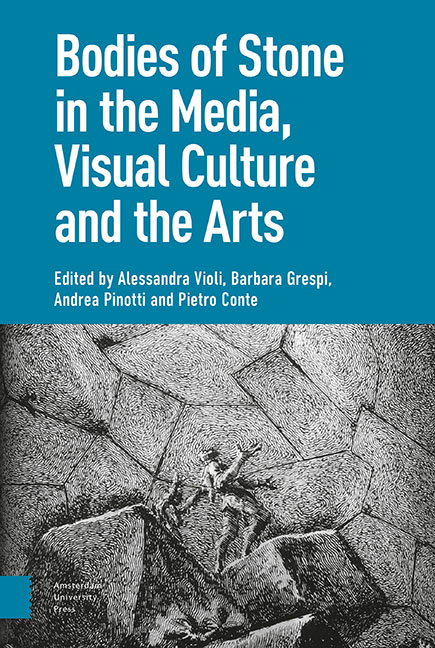Book contents
- Frontmatter
- Contents
- Introduction: Learning from Stone
- I Statue: The Imaginary of Uncertain Petrification
- 1 Theatre and Memory: The Body-as-Statue in Early Modern Culture
- 2 Translated Bodies: A ‘Cartographic’ Approach
- 3 Pantomime in Stone: Performance of the Pose and Animal Camouflage
- 4 Animated Statues and Petrified Bodies: A Journey Inside Fantasy Cinema
- 5 The Ephemeral Cathedral: Bodies of Stone and Configurations of Film
- II Matter: Size, Hardness, Duration
- 1 Bodies That Matter: Miniaturisation and the Origin(s) of ‘Art’
- 2 Brancusi’s ‘Sculpture for the Blind’
- 3 Cinema, Phenomenology and Hyperrealism
- 4 Ephemeral Bodies: The ‘Candles’ of Urs Fischer
- 5 The Celluloid and the Death Mask: Bazin’s and Eisenstein’s Image Anthropology
- III Corpse: Fossils, Auto-Icons, Revenants
- 1 Funeral Eulogy: Post-Mortem Figures and Redeemed Bodies, in Images
- 2 On Jack Torrance As a Fossil Form
- 3 Technical Images and the Transformation of Matter in Eighteenth-Century Tuscany
- 4 Glass, Mixed Media, Stone: The Bodily Stuffs of Suspended Animation
- 5 Bodies’ Strange Stories: Les Revenants and The Leftovers
- IV Monument: Embodying and Grafting
- 1 The Impassibly Fleshly, the Statue of the Impossible
- 2 Frozen into Allegory: Cleopatra’s Cultural Survival
- 3 The Orphan Image
- 4 The Well-Tempered Memorial: Abstraction, Anthropomorphism, Embodiment
- 5 Monuments of the Heart: Living Tombs and Organic Memories in Contemporary Culture
- Index
4 - Glass, Mixed Media, Stone: The Bodily Stuffs of Suspended Animation
Published online by Cambridge University Press: 20 November 2020
- Frontmatter
- Contents
- Introduction: Learning from Stone
- I Statue: The Imaginary of Uncertain Petrification
- 1 Theatre and Memory: The Body-as-Statue in Early Modern Culture
- 2 Translated Bodies: A ‘Cartographic’ Approach
- 3 Pantomime in Stone: Performance of the Pose and Animal Camouflage
- 4 Animated Statues and Petrified Bodies: A Journey Inside Fantasy Cinema
- 5 The Ephemeral Cathedral: Bodies of Stone and Configurations of Film
- II Matter: Size, Hardness, Duration
- 1 Bodies That Matter: Miniaturisation and the Origin(s) of ‘Art’
- 2 Brancusi’s ‘Sculpture for the Blind’
- 3 Cinema, Phenomenology and Hyperrealism
- 4 Ephemeral Bodies: The ‘Candles’ of Urs Fischer
- 5 The Celluloid and the Death Mask: Bazin’s and Eisenstein’s Image Anthropology
- III Corpse: Fossils, Auto-Icons, Revenants
- 1 Funeral Eulogy: Post-Mortem Figures and Redeemed Bodies, in Images
- 2 On Jack Torrance As a Fossil Form
- 3 Technical Images and the Transformation of Matter in Eighteenth-Century Tuscany
- 4 Glass, Mixed Media, Stone: The Bodily Stuffs of Suspended Animation
- 5 Bodies’ Strange Stories: Les Revenants and The Leftovers
- IV Monument: Embodying and Grafting
- 1 The Impassibly Fleshly, the Statue of the Impossible
- 2 Frozen into Allegory: Cleopatra’s Cultural Survival
- 3 The Orphan Image
- 4 The Well-Tempered Memorial: Abstraction, Anthropomorphism, Embodiment
- 5 Monuments of the Heart: Living Tombs and Organic Memories in Contemporary Culture
- Index
Summary
Abstract
The essay takes ‘bodies of stone’ in its actual, literal sense, discussing nineteenth-century embalming techniques which involved a material transformation of human remains into glass, mixed media or stone. These processes of vitrification or petrification provided, on the one hand, auto-icons of the dead that seemed to rival the chemical immortality offered by the emergent media, such as photography or film. On the other hand, by mimicking natural processes of fossilisation, bodies of glass or stone were infused with vitalist notions of matter, hinting at states of suspended animation and latent life. The essay explores this ‘biochemical constellation of immortality’ through some peculiar nineteenth-century examples and traces the uncanny survival of these living corpses in today's pop cultural imaginary.
Keywords: Vitrification; petrification; Jeremy Bentham; Efisio Marini; Pietro Gorini; Jean Jacques Rousseau
The human world of stones is caught in organic metaphors like flies in amber.
‒ A.S. Byatt, The Stone WomanMatter in large masses must always be fixed and dear; form is cheap and transportable.
‒ O. Wendell Holmes, The Stereoscope and the Stereograph
In the August 1898 issue of La Revue de Revues, some of the latest and most astonishing discoveries in the field of science were revealed to a wider public: in between a ‘marvelous’ technique for ‘[t]he liquefaction of air’ and a surprising apparatus for measuring thought (‘[t]he machine to measure thought’), a long article described a recent breakthrough on ‘[t]he survival of the body’. This was anatomist Efisio Marini's system for turning human flesh into stone. What the article dubbed a ‘transformation of the human body into marble’ involved the total mineralisation of a dead body so as to preserve its structure and morphological characteristics intact. The dead were transformed into statues, but the wonder of Marini's secret for petrification was its reversibility: by plunging the marbled ‘pieces’ into a special, regenerating fluid, the body's tissues surprisingly regained their ‘volume, freshness, elasticity and normal colour’. Stone was turned back into flesh. The whole process could, of course, be repeated indefinitely, giving a sense that those bodies were not dead at all. Rather, they shifted between inanimate and animate states, leaving viewers in ‘enchanted’ suspension as to whether they were looking at embodied humans, marble artefacts or the puzzling objets d’artthat readers could see for themselves in the photographs accompanying the article.
- Type
- Chapter
- Information
- Bodies of Stone in the Media, Visual Culture and the Arts , pp. 261 - 276Publisher: Amsterdam University PressPrint publication year: 2020

